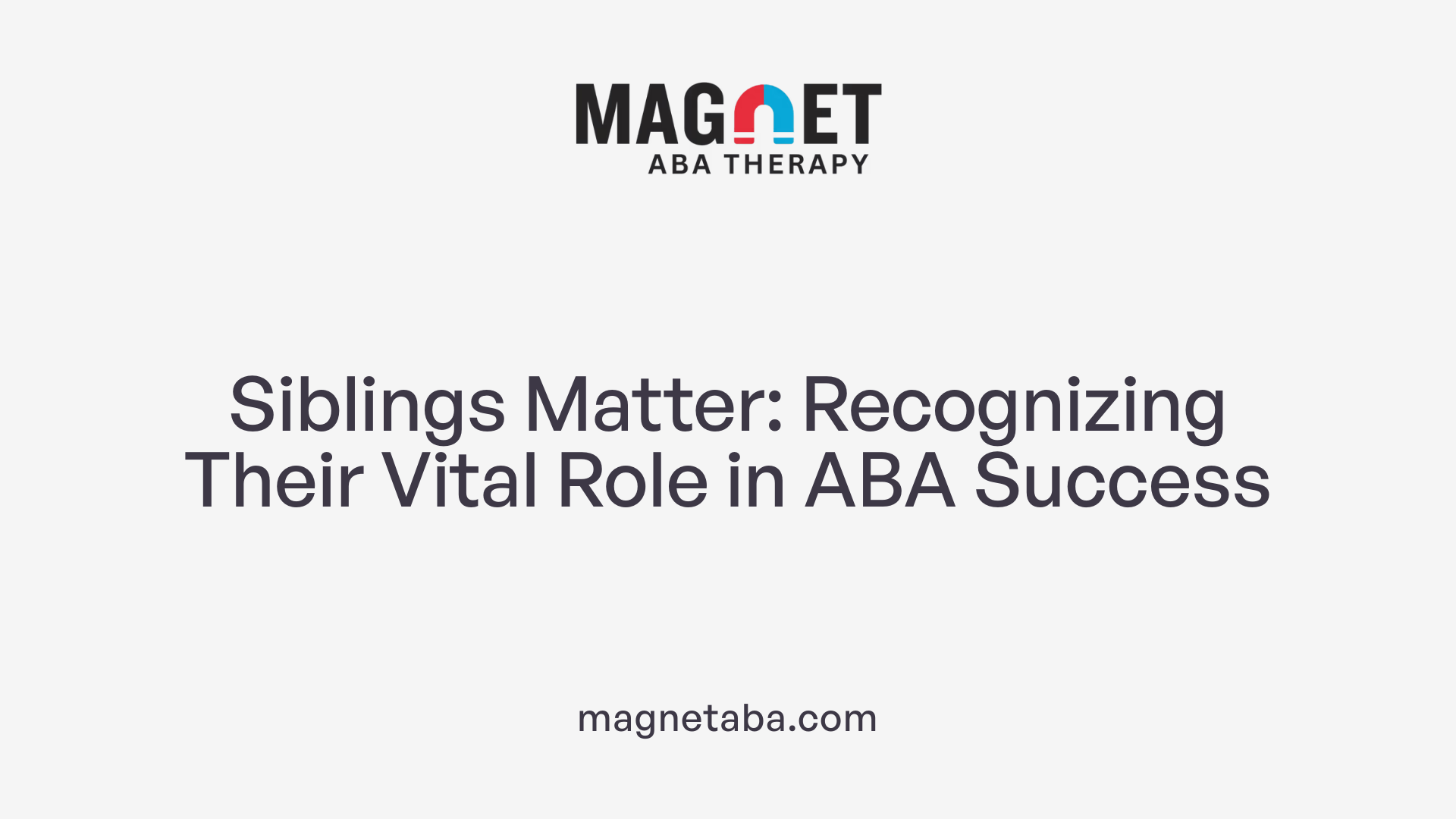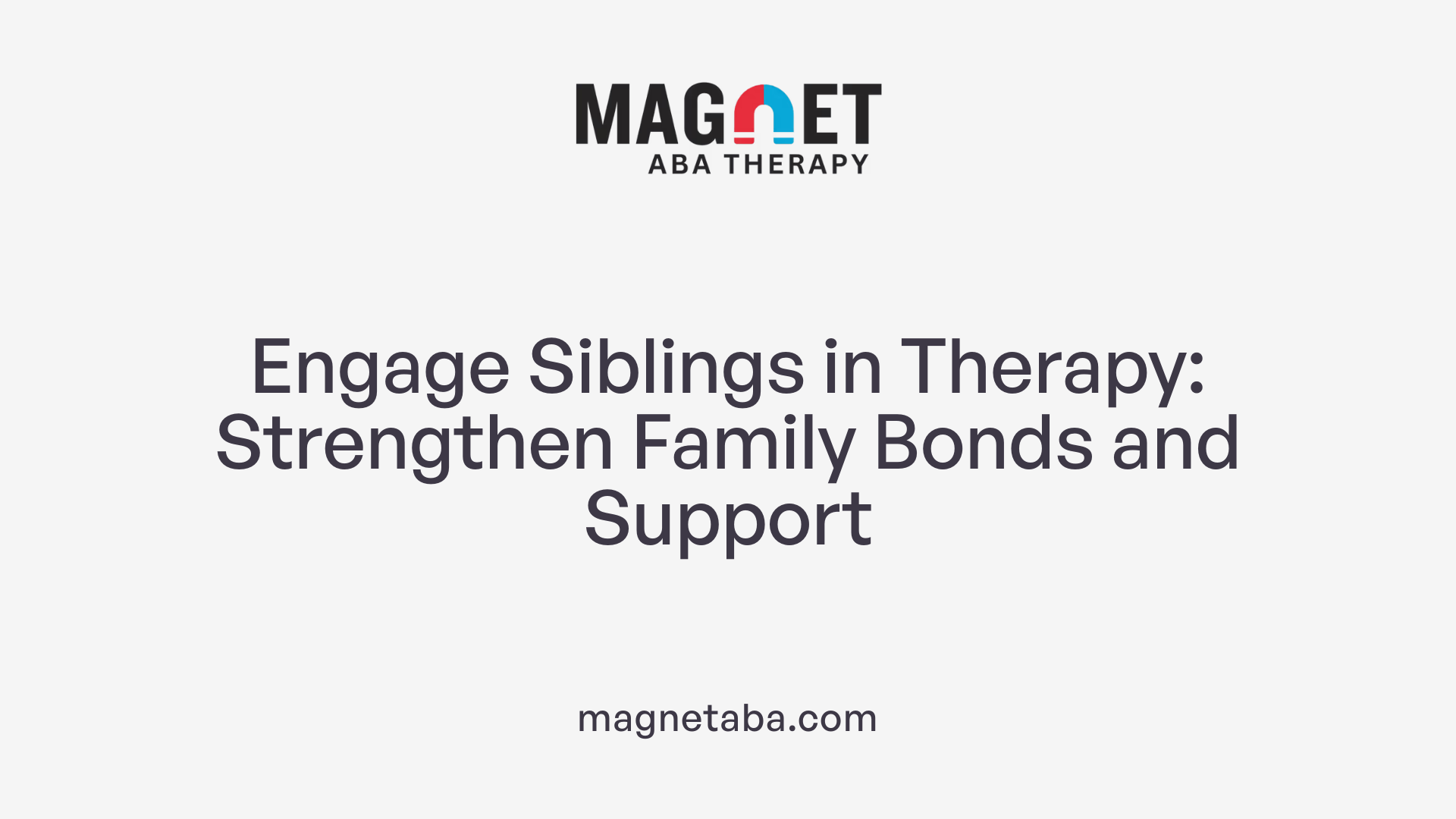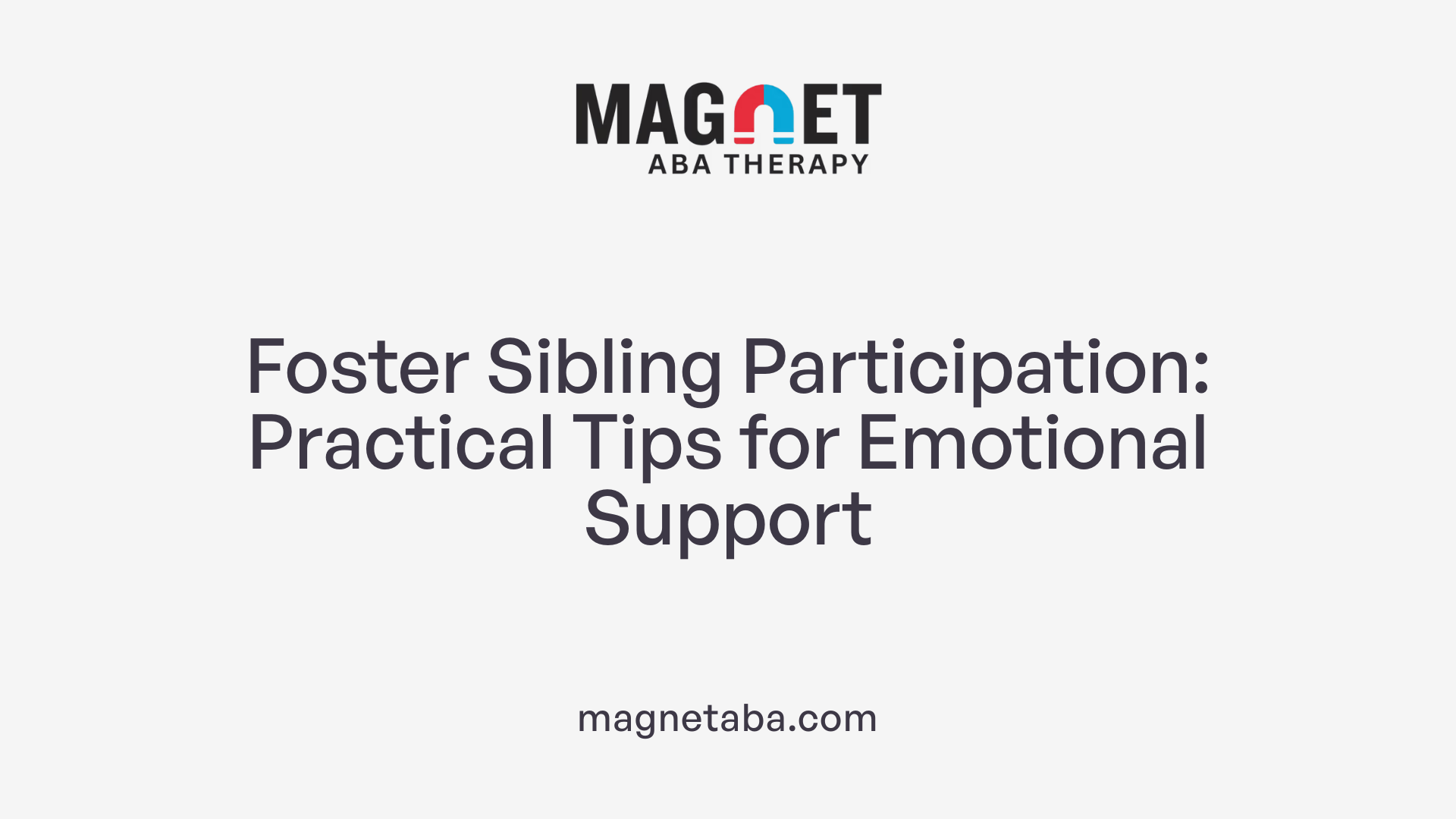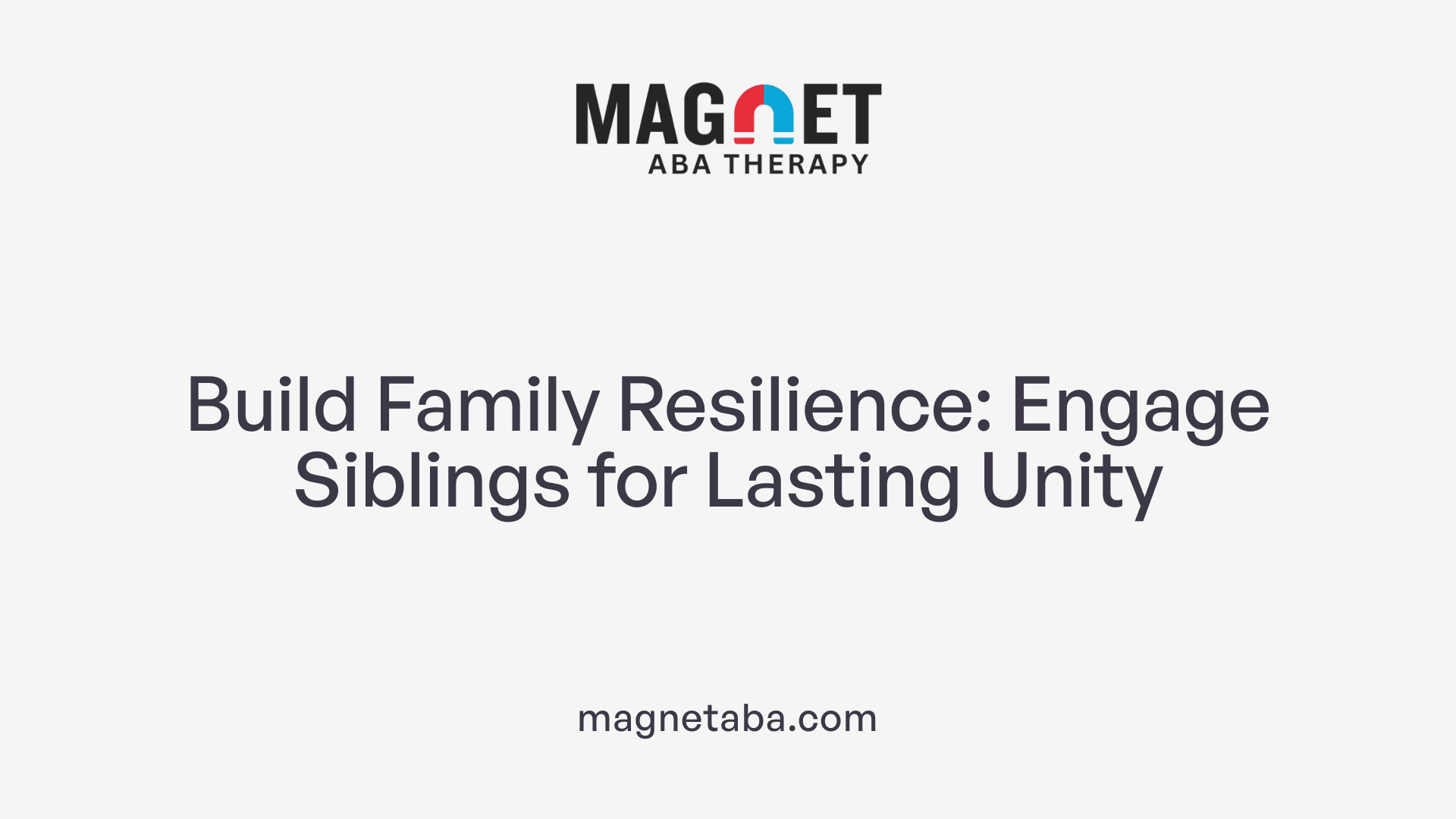Understanding the Vital Role of Siblings in the ABA Process
Involving siblings in the ABA journey of a child with autism is more than just inclusive; it’s a strategic approach to enhance therapy outcomes and strengthen family bonds. Siblings can act as compassionate role models, provide emotional support, and help generalize skills learned in therapy to everyday life. This article explores practical strategies, educational approaches, and effective family engagement methods to ensure siblings are active, understanding, and supportive participants in the autism therapy process.
Recognizing the Importance of Siblings in ABA Therapy

What are the benefits of involving siblings in the ABA journey?
Including siblings in ABA therapy offers many advantages for the entire family. Siblings can model positive behaviors such as sharing, patience, and following routines, which reinforces learning during therapy sessions. Their involvement promotes a better understanding of autism, reducing stigma and fostering empathy within the family.
Participation in shared activities, like cooperative play, outdoor games, or simple routines such as mealtime and cleaning, helps children practice social skills like turn-taking, greeting, and waiting. Moreover, siblings can provide emotional support, boosting the autistic child's self-esteem and creating strong bonds. Reinforcing lessons outside of therapy, such as praising appropriate behavior or sharing toys, helps solidify progress.
How does high-quality ABA support sibling interactions?
High-caliber ABA services focus on improving essential skills such as communication, personality traits, and social capabilities. These improvements foster better sibling relationships by promoting effective communication and patience.
ABA interventions teach children to recognize non-verbal cues, respond socially, and manage emotions, which enhances everyday sibling interactions. Structured play and joint activities help children develop empathy, understanding, and cooperation, making family life more harmonious.
Family-wide involvement benefits
Engaging the whole family in ABA therapy creates a supportive environment that helps normalize the therapy process. It encourages teamwork and understanding challenges and strengths, leading to stronger familial bonds.
Parents who include siblings in conversations, goal-setting, and activities related to ABA increase family cohesion. They also support sibling well-being through support groups, individual time, and educational resources, which can alleviate stress and foster positive relationships.
Amy Ursitti’s emphasis on family inclusion
Amy Ursitti, a sibling of a person with autism, highlights the significance of involving the entire family, especially siblings, in the therapy process. She emphasizes that children learn by observing and participating, making sibling involvement vital. With appropriate guidance, siblings can become model peers and emotional supporters, enriching the therapy experience and promoting family unity.
Including siblings in ABA therapy not only benefits the child's developmental progress but also strengthens family bonds and encourages a culture of understanding, patience, and teamwork.
Educational Strategies for Siblings to Understand Autism and ABA

How can families support siblings’ understanding of autism and ABA?
Supporting siblings' understanding of autism and ABA involves a combination of educational and practical approaches. Families can provide age-appropriate resources such as books, videos, and social stories designed specifically for children. These materials help explain autism in a way that is accessible and relatable.
Involving siblings in therapy-related activities when suitable allows them to observe and participate in the process, fostering a sense of inclusion and understanding. Visual tools like first-then boards, social stories, and emotion charts can illustrate routines and social expectations clearly.
Modeling positive behaviors and encouraging open conversations about differences promote empathy and acceptance within the family. This approach helps siblings see autism as part of the child's unique identity, fostering respect and stronger bonds.
What tools or methods can help siblings manage their feelings?
Siblings may experience a variety of emotions, from pride and support to frustration or confusion. To manage these feelings effectively, visual aids like emotion charts and social stories are invaluable.
Open discussions about feelings—using language easily understood by children—normalize the emotional experience. These conversations help siblings express their emotions constructively and recognize that their feelings are valid.
Teaching emotional intelligence through role-playing, storytelling, and visual tools allows siblings to better understand and manage their own emotions. Creating a supportive environment in the home encourages emotional sharing without judgment, which strengthens family relationships and aids in managing emotional stress.
Integrating Siblings into Therapy Sessions and Activities

How can siblings participate effectively in ABA sessions?
Involving siblings in ABA therapy sessions can enhance both the child's progress and family bonds. Under the supervision of an qualified ABA therapist, siblings can actively engage in structured activities designed to reinforce learning. They can serve as peer models, demonstrating appropriate communication and social skills.
Siblings can also help reinforce lessons during daily routines by practicing skills like sharing, turn-taking, and patience. For example, they can participate in role-playing exercises, use visual aids like token charts to encourage participation, and offer positive reinforcement with praise or high-fives. This collaborative approach encourages siblings to learn and model behaviors that support the child's growth.
What family activities can reinforce therapy goals?
Family routines and shared activities are great opportunities to reinforce therapy objectives outside formal sessions. Activities such as cooperative games, outdoor adventures, storytelling, cooking, and music or dance sessions serve multiple purposes.
These shared experiences not only make therapy goals tangible but also foster family cohesion. During these activities, parents can incorporate social skills like greetings, waiting for turns, and sharing, making them natural learning moments. When family members participate actively in therapy-related routines, it normalizes the process, reduces stigma, and strengthens sibling relationships.
How do reinforcement and modeling come into play?
Reinforcement and modeling are foundational elements of ABA that siblings can help facilitate naturally. By offering praise, verbal encouragement, or sharing toys, siblings can reinforce desired behaviors in a supportive way.
Modeling positive behaviors—such as patience, sharing, appropriate greetings, and calm responses—serves as an effective teaching tool. Siblings acting as role models provide consistent and relatable examples, making social cues and communication skills easier to learn.
Together, these strategies create a family environment where therapy goals are integrated into daily life, empowering siblings to contribute positively to their brother or sister’s development.
Strategies and Techniques to Foster Sibling Participation and Emotional Support

What practical tips support sibling participation?
Encouraging open dialogue is vital; parents should foster honest conversations about autism and ABA therapy, helping siblings understand what to expect. Involving siblings in decision-making processes related to family routines or therapy goals makes them feel valued and included. Providing individual recognition—like praise or special activities—acknowledges each child's unique contributions and efforts. Creating shared goals through activities such as cooperative play or family projects encourages siblings to actively engage. These shared experiences foster empathy, teamwork, and understanding. Additionally, involving siblings in therapy sessions under professional guidance helps them learn supporting skills and reinforces lessons learned during therapy.
How can parents ensure siblings are not overwhelmed?
It's crucial for parents to set clear boundaries, ensuring siblings aren't used solely as substitutes for therapists or overwhelmed by therapy-related tasks. Respecting their feelings and giving them space when needed is essential; gradual involvement helps prevent emotional fatigue. Providing individual attention to each child balances family dynamics and ensures siblings feel appreciated and not sidelined. Regular family meetings to discuss concerns, celebrate successes, and clarify expectations help maintain a healthy balance. By promoting open communication, setting appropriate limits, and respecting each sibling's emotional needs, families can create an environment that supports both the autistic child and their siblings, fostering stronger bonds.
Celebrating achievements
Celebrating milestones together strengthens family bonds and creates positive memories. Recognizing each sibling’s efforts and successes, no matter how small, boosts their confidence and involvement. Small celebrations, awards, or family outings can reinforce the value of participation. Shared achievements foster a sense of unity and motivate ongoing engagement with therapy goals. When siblings see progress and are involved in the journey, they develop a supportive attitude that benefits the entire family.
| Strategy | Implementation Tips | Benefits |
|---|---|---|
| Open communication | Use visual aids, active listening, and honest discussions | Reduces misunderstandings, builds trust |
| Balancing attention | Provide individual quality time, set boundaries, involve gradually | Prevents feelings of neglect or overload |
| Celebrating achievements | Recognize efforts, use rewards, and involve everyone in celebrations | Strengthens bonds, increases motivation |
Enhancing Family Unity and Resilience through Sibling Engagement

How does involving siblings improve family dynamics?
Including siblings in ABA therapy and daily routines helps build a stronger, more understanding family environment. When the entire family participates in shared activities like play, mealtime, or outings, it fosters cooperation and empathy. Celebrating small achievements together, such as learning a new skill or completing a family project, reinforces a sense of teamwork and pride.
Shared routines like brushing teeth or cleaning up not only teach skills but also create predictable, comforting moments for everyone. These experiences promote patience, communication, and mutual support.
Finally, celebrating milestones—from academic progress to social skill improvements—strengthens family bonds. It helps all members recognize progress and face challenges collectively, building resilience.
Support groups and community resources
To support sibling involvement, families can turn to various resources. Support groups like Sibshops and other community programs provide safe spaces for siblings to share experiences, learn coping strategies, and feel understood.
Parent coaching and educational workshops also offer practical advice for integrating siblings into ABA routines, promoting effective communication and emotional support.
Local community centers often run family-oriented activities designed to increase family cohesion and sibling interaction.
Celebrating milestones together
Recognizing and celebrating achievements together not only motivates the child receiving ABA therapy but also reinforces positive sibling relationships. This could be through a family outing, a small party, or even a special mention during family meetings.
Such celebrations create positive memories, encourage shared pride, and promote a family culture of support and understanding.
| Strategy | Description | Benefits |
|---|---|---|
| Routine involvement | Participating in daily activities and chores together | Builds skills, patience, and teamwork |
| Shared special activities | Activities like cooking, games, or outdoor adventures | Strengthens emotional bonds, creates positive shared experiences |
| Milestone celebrations | Recognizing progress with family gatherings | Reinforces family support, boosts self-esteem |
| Community support | Joining groups like Sibshops and family programs | Provides education, emotional support, and practical advice |
How can families foster continuous sibling involvement?
Effective communication is essential. Open dialogue about feelings, expectations, and experiences helps siblings understand each other.
Regular family meetings to plan activities, discuss progress, and celebrate achievements can keep involvement ongoing. Individual attention to each child is crucial to address unique needs and prevent feelings of neglect.
Including siblings as peer models during therapy sessions and in social skills groups encourages positive interactions. Setting clear boundaries ensures that siblings feel supported without being overwhelmed.
Ultimately, fostering a family environment rooted in respect, empathy, and teamwork leads to a resilient, united family—ready to support each member's growth and success in ABA therapy.
Long-term Benefits of Sibling Involvement and Active Family Participation
What are the long-term benefits of involving siblings?
Involving siblings in ABA therapy and family activities offers lasting positive effects. Siblings learn to develop empathy and patience, which helps in building supportive, lifelong relationships. Their participation in therapy processes fosters understanding about autism, reducing stigma and misconceptions. Over time, these experiences cultivate resilience and social skills, enabling siblings to become compassionate and effective caregivers or friends in their adult lives.
Moreover, siblings who are actively involved tend to integrate therapy concepts naturally into daily routines, supporting ongoing development and fostering an inclusive family environment. Such involvement encourages normalizing therapy processes and building family unity, which can lead to a more harmonious household where everyone's needs and strengths are recognized.
How do these practices impact the child’s development and family health?
Consistent involvement of siblings can significantly boost the child’s developmental outcomes, including improvements in communication, social participation, and emotional regulation. Siblings acting as social role models during structured play and daily routines reinforce learning objectives from therapy sessions.
Furthermore, incorporating siblings in activities and therapy strategies creates a supportive family ecosystem. This collaboration fosters open communication, reduces misunderstandings, and promotes mutual respect among family members. As a result, the family becomes more resilient and adaptive to challenges, which enhances overall well-being.
Creating shared positive experiences through cooperative activities not only supports the child's growth but also strengthens sibling bonds and enhances family cohesion. Both the children with autism and their siblings benefit from an environment rooted in understanding, patience, and teamwork, contributing to a healthier, balanced family dynamic.
| Aspect | Impact | Additional Details |
|---|---|---|
| Empathy development | Long-term compassionate relationships | Siblings learn to recognize emotions and respond supportively |
| Social skills | Improved interaction abilities | Practice turns, sharing, and joint attention activities |
| Family harmony | Reduced conflicts and misunderstandings | Regular family meetings and shared routines |
| Emotional resilience | Better coping with stress and changes | Support groups and individualized attention |
| Overall family health | Strengthened family unit | Consistent strategies and positive reinforcement |
Fostering these qualities within the family not only maximizes the benefits of ABA therapy but also builds a nurturing environment where each member can flourish, creating lifelong bonds and resilience.
Building a Supportive and Cohesive Family Through Sibling Involvement
Integrating siblings into the ABA journey involves education, participation, and emotional engagement. By fostering understanding, supporting shared activities, and respecting individual needs, families can create an environment where all members feel valued and empowered. When siblings become active participants rather than passive observers, the entire family benefits from stronger bonds, better communication, and a collective commitment to growth and acceptance. Regularly updating strategies, celebrating milestones, and encouraging open, honest conversations ensure that sibling involvement continues to enrich the therapy process and family life.
References
- Considerations For Sibling Involvement In Your Child's ABA Program
- Supporting Sibling Relationships in Autism Families Using ABA
- Sibling Support: Involving Brothers and Sisters in ABA Therapy
- How to Involve Brothers and Sisters in ABA Therapy Goals
- Help Siblings of Children with Autism Thrive - Strive ABA Consultants
- ABA Therapy Near me: Supporting Siblings in Treatment
- Empowering Siblings in the ABA Therapy Journey - Brightside ABA











